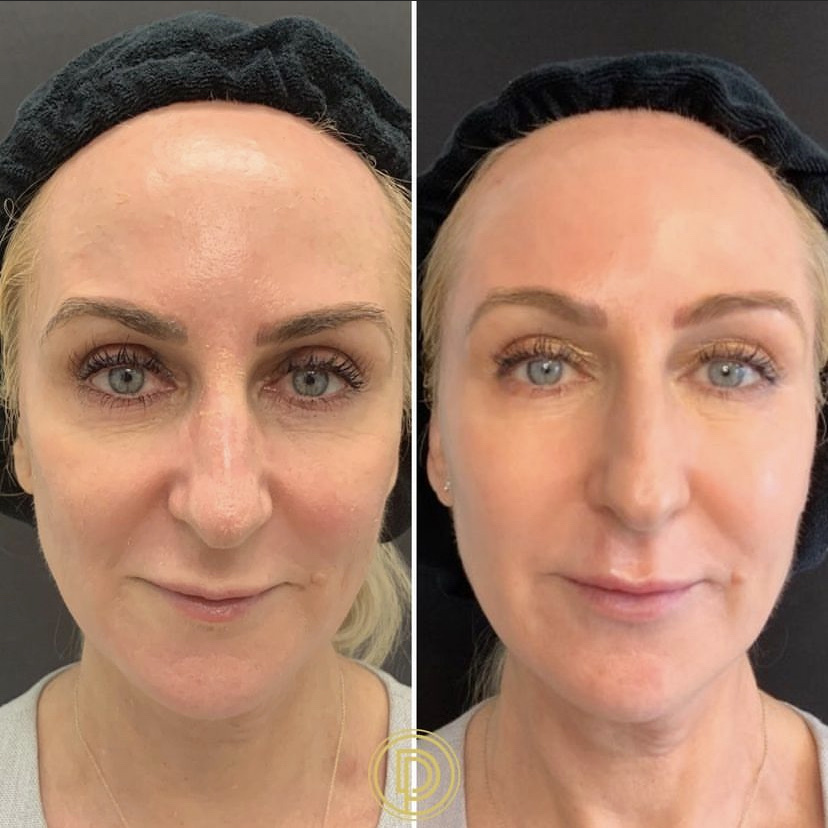Yes, Sculptra can help improve the appearance of nasolabial folds by stimulating collagen production in the surrounding areas, particularly in the cheeks, jawline and lateral face, that have experienced volume loss which provides subtle facial lift.
What are nasolabial folds?
Nasolabial folds, commonly known as smile lines, are the creases that run from the sides of your nose to the corners of your mouth. While they’re a natural part of your facial anatomy, they become more prominent with age. This happens as collagen production decreases, fat pads shift downward, and skin loses its elasticity and volume. As a result, the midface begins to sag, making these folds appear deeper.
At Dallas Dermatology Partners, our dermatologists take a strategic and artistic approach by using Sculptra to restore volume and structure in the areas that influence these folds. Instead of injecting directly into the lines, we target surrounding regions like the upper cheeks to lift and support the skin naturally.
Why we treat around the folds instead of injecting into them
Although Sculptra is FDA-approved to treat nasolabial folds, we often avoid placing it directly into these creases. That’s because Sculptra is a collagen stimulator, not a gel filler. Direct injection into these mobile, high-motion areas can increase the risk of unevenness or nodule formation.
Instead, we place it where it can safely rebuild collagen and gently lift the lower face. By restoring lost volume in the upper cheeks and temples, the folds soften as the skin regains its structure and support.
How do nasolabial folds form in the first place?
Several age-related factors contribute to the deepening of nasolabial folds:
- Loss of collagen and elastin reduces skin firmness and resilience
- Downward shift of facial fat pads causes sagging in the midface
- Repeated facial expressions deepen the lines over time
- Thinning skin makes folds more visible
- Significant weight loss
This process begins in your 30s and progresses with age, though sun exposure, genetics, and lifestyle can speed it up. Treatments that restore facial volume and support, like Sculptra, can help reverse these changes without making your face look overfilled or unnatural.

The science behind Sculptra: How it actually works on your skin
Sculptra is made from poly-L-lactic acid (PLLA), a biocompatible substance that stimulates your body’s natural collagen production. Once injected, it triggers a controlled inflammatory response that activates fibroblasts—cells responsible for creating new collagen fibers. Over several weeks, your skin begins to rebuild its internal support system, leading to:
- Improved skin thickness and firmness
- Increased volume in areas of hollowing
- A gradual, natural-looking lift in the midface
Because Sculptra works with your body’s own regenerative processes, results appear slowly and last longer, typically up to two years or more.
How much Sculptra will you need to see visible results?
The amount of Sculptra needed varies based on your age, facial anatomy, and treatment goals. Most patients need 1 to 2 vials per session, with 2 to 3 treatment sessions spaced about four to six weeks apart. Our dermatologists assess your skin carefully to design a plan that delivers natural-looking improvement over time, not an abrupt change.
Where we place Sculptra to improve nasolabial folds
For effective and safe correction, Sculptra is placed in surrounding areas that influence facial support:
- Upper cheeks near the temples
- Lateral cheeks for volume and lift
- Temples and jawline if additional structure is needed
By strengthening these areas, we’re able to reduce the appearance of folds while maintaining facial harmony. This technique ensures a balanced, lifted look that evolves gradually.
Is Sculptra the best option for treating nasolabial folds?
Sculptra is an excellent choice for patients looking for long-term facial rejuvenation. However, it may not be right for everyone. Hyaluronic acid fillers, such as Juvederm or Restylane, can be used for immediate softening of deep folds. In many cases, we recommend a combination approach using hyaluronic acid fillers for short-term improvement and Sculptra for long-term collagen support.
During your consultation, we’ll walk you through all options and design a treatment plan tailored to your goals, skin condition, and lifestyle.
Why Dallas Dermatology Partners is trusted for cosmetic injectables
Our board-certified dermatologists bring over 65 years of combined experience in both medical and cosmetic dermatology. As D Magazine Best Doctors, we focus on providing results that are refined, natural, and aligned with your unique facial anatomy. Whether you’re exploring injectables in Dallas for the first time or seeking a more advanced solution, our team is here to guide you every step of the way.
Take the next step toward smoother, lifted skin
Ready to learn more about what Sculptra can do for your nasolabial folds? Schedule your Dallas dermatology appointment today and let’s create a personalized plan for radiant, youthful results.
